Top 9 AI Tools for Account Executives in 2025: Features, Use Cases, and Comparison
This blog explores the top use cases, tools, and strategies for AEs in 2025 and shows how purpose-built platforms like Inventive AI extend beyond outreach to help AEs win evaluator-driven deals with speed and precision.
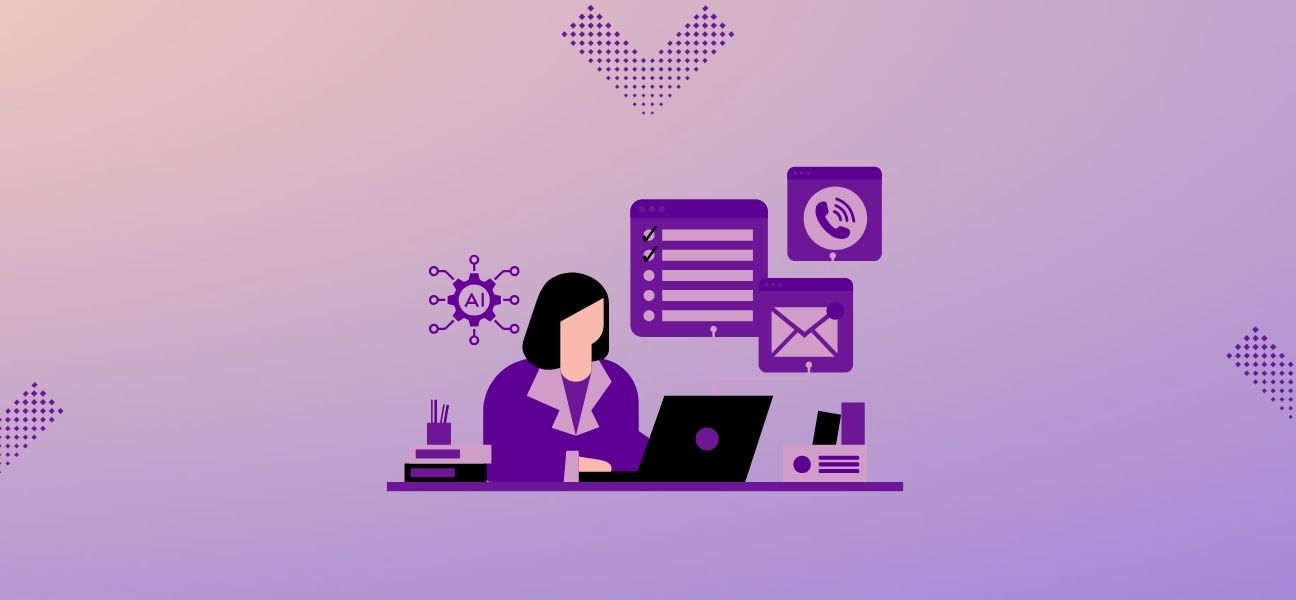
Account executives (AEs) sit at the center of revenue growth. They’re responsible for qualifying opportunities, building relationships, managing forecasts, and closing deals. Yet, most AEs spend more time on CRM updates, email drafting, and admin tasks than on direct selling.
Research from McKinsey shows that sellers spend less than 30% of their time with customers, with the rest consumed by internal processes, reporting, and manual preparation tasks. In competitive SaaS and B2B markets, this imbalance slows down pipeline velocity and limits win rates.
AI is changing that equation. From automatically scoring leads to drafting proposals and surfacing the right content in seconds, AI tools help account executives reclaim selling time, improve accuracy, and close more deals.
This blog explores the top use cases, tools, and strategies for AEs in 2025 and shows how purpose-built platforms like Inventive AI extend beyond outreach to help AEs win evaluator-driven deals with speed and precision.
Key Takeaways
- AI helps AEs spend more time selling by automating CRM updates, drafting, and content retrieval.
- Core AE use cases: lead scoring, personalized outreach, conversation intelligence, forecasting, and proposal support.
- Top tools include sales engagement, forecasting, conversation intelligence, and proposal automation platforms.
- Inventive AI adds unique value by supporting proposal drafting, aligning responses to evaluator priorities, and reducing admin load in late-stage deals.
What Is an AI Account Executive (AE)?
An AI Account Executive isn’t a different job title it’s the modern evolution of the AE role powered by intelligent automation. Instead of spending hours on manual, low-value tasks like CRM updates, proposal drafting, or data entry, AI-enabled AEs use purpose-built tools to handle these activities automatically.
By delegating repetitive work to AI systems, Account Executives can focus on high-value selling, building relationships, understanding buyer needs, and strategizing deal-winning narratives. The result is a more efficient, data-driven AE who spends less time on admin and more time driving revenue, accuracy, and customer trust.
Why AI Matters for Account Executives
The AE role has never been more complex. AEs juggle prospecting, deal strategy, pipeline reporting, and collaboration with presales and revenue teams. Buyer expectations are also higher; stakeholders want personalized, timely, and accurate interactions at every touchpoint.
Without AI, AEs face three recurring challenges:
- Too much time lost on low-value tasks
CRM updates, email drafting, and admin eat into selling hours. - Inconsistent messaging and proposals
When content is scattered across drives, emails, or outdated decks, AEs risk sending incomplete or misaligned responses. - Forecasting blind spots
Manual pipeline updates lead to poor visibility, late-quarter surprises, and missed targets.
AI addresses these pain points head-on:
- Automating admin and CRM work
- Surfacing relevant content and case studies instantly
- Drafting accurate proposals from verified sources
- Highlighting risks in deals before they slip
For AEs, AI is not about replacing judgment; it’s about spending less time in spreadsheets and more time building buyer trust.
Also read: RFP Automation Checklist for Sales Success
AI’s Role: Co-Pilot, Not Replacement (The Human Element in AE Success)
AI has become an essential part of the Account Executive’s toolkit, but it’s not a substitute for human expertise. While AI automates data entry, proposal drafting, and content retrieval, it still lacks the empathy, judgment, and nuance that define top-performing AEs.
The best outcomes happen when AI acts as a co-pilot, handling repetitive, low-value work, while the AE remains the strategic driver of every deal. Emotional intelligence, relationship-building, negotiation skills, and storytelling are uniquely human strengths that no algorithm can replicate.
AI can flag deal risks or generate drafts, but it can’t read a room, sense hesitation on a call, or build trust with multiple stakeholders. That’s where Account Executives excel. By combining automation with human insight, AEs can sell smarter, respond faster, and deliver experiences that feel both intelligent and personal, a balance no fully automated system can achieve.
Core Use Cases of AI for Account Executives
AI isn’t just about speed; it’s about helping AEs focus where their expertise matters most. Below are the most important use cases that directly impact AE productivity, accuracy, and win rates.
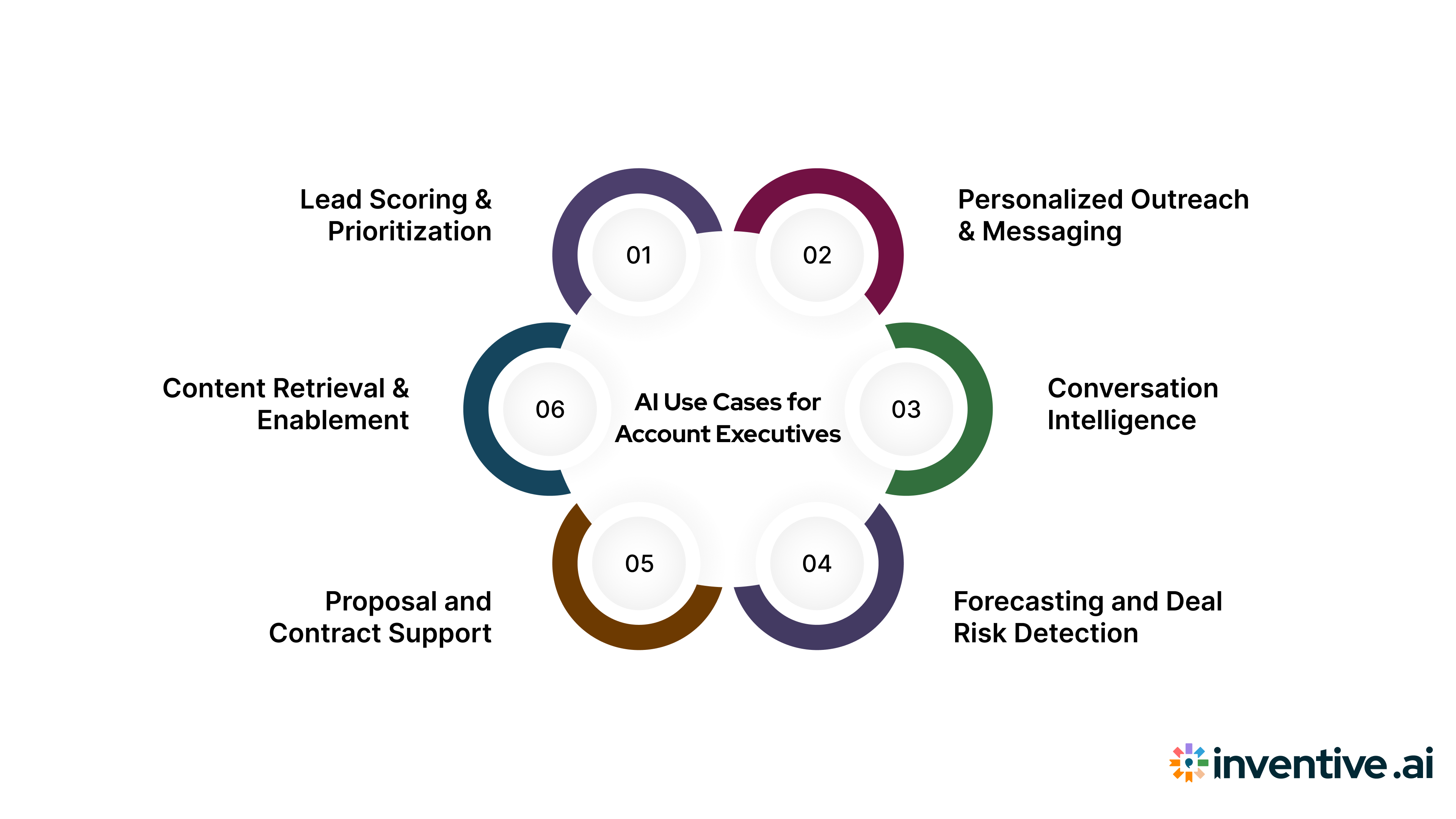
1. Lead Scoring and Opportunity Prioritization
The challenge: Account executives often waste time chasing the wrong prospects. Without clear prioritization, deals stall or pipelines bloat with low-quality opportunities.
How AI helps:
- Predictive lead scoring uses intent data, engagement signals, and firmographics to highlight the best-fit accounts.
- Machine learning models detect buying-stage signals (website visits, content downloads, stalled communication).
- AEs know which accounts are warming up and where to focus their energy.
Example: AI tools like 6sense or Clari analyze pipeline health to show which opportunities are most likely to close, helping AEs avoid dead-end deals and prioritize in-market buyers.
Also read: Understanding the Request for Quote (RFQ) Process
2. Personalized Outreach and Messaging
The challenge: Buyers ignore generic outreach. Salesforce’s State of Sales report notes that 84% of customers say being treated like a person, not a number, is key to winning their business. But personalization is time-consuming when AEs manage dozens of accounts.
How AI helps:
- AI generates email drafts, LinkedIn messages, and call scripts tailored to buyer persona, industry, or past interactions.
- Outreach tools use sentiment analysis to recommend subject lines, timing, and tone.
- AI reduces the grunt work while AEs fine-tune the message.
Example: Instead of manually building every email sequence, AEs can use AI to prepare personalized drafts at scale, then add strategic touches that reflect buyer priorities.
Also read: Understanding the Request for Quote (RFQ) Process
3. Conversation Intelligence and Coaching
The challenge: It’s hard for AEs to capture every objection, competitor mention, or buying signal during calls and demos. Manual notes miss critical context.
How AI helps:
- Conversation intelligence tools like Gong analyze calls for sentiment, objections, competitor mentions, and buying signals.
- AI provides post-call summaries, highlighting risks or opportunities for follow-up.
- Managers can coach AEs based on real buyer interactions instead of anecdotal feedback.
Example: After a demo call, AI surfaces that the buyer raised security concerns twice and mentioned a competitor once. This insight helps the AE loop in presales and prepare stronger follow-ups.
4. Forecasting and Deal Risk Detection
The challenge: Pipeline reviews are often based on gut feel. AEs update forecasts manually, which leads to blind spots, missed risks, and late-quarter surprises.
How AI helps:
- Forecasting platforms like Clari analyze CRM activity, email/call data, and pipeline velocity to predict deal outcomes.
- AI surfaces “at-risk” opportunities by flagging silent accounts, missing technical validations, or stalled stakeholders.
- Instead of waiting until the last week of the quarter, AEs can course-correct earlier.
Example: An AE sees that a $500K deal hasn’t had buyer engagement for 21 days. AI flags it as “slipping,” prompting the AE to re-engage decision makers.
5. Proposal and Contract Support
The challenge: Complex B2B deals often require tailored proposals, contracts, or compliance-heavy responses. AEs working without presales support risk sending incomplete or inconsistent documents.
How AI helps:
- Proposal automation platforms like Inventive AI generate first drafts 10× faster, with 95% accuracy and 0% hallucination.
- Win Themes ensure responses align with buyer evaluation criteria, making proposals competitive, not just accurate.
- AI Content Manager automatically flags outdated or conflicting responses before they reach the buyer.
Outcome: AEs no longer start from scratch. They refine AI-generated drafts and focus on storytelling and relationship-building. This reduces stress, shortens sales cycles, and increases evaluator scores.
Also read: RFP Content Management Best Practices and Tips
6. Content Retrieval and Sales Enablement Guidance
The challenge: AEs often lose hours digging through old decks, spreadsheets, or SharePoint folders to find case studies, product specs, or objection responses.
How AI helps:
- AI knowledge hubs surface the right content in seconds, from case studies to compliance details.
- Inventive AI consolidates RFPs, proposals, and technical responses into a single hub, ensuring AEs always have the latest version.
- Freshness checks flag outdated assets, reducing compliance risk.
Example: During a call, an AE is asked for a healthcare compliance reference. Instead of chasing the legal team, AI instantly surfaces the most recent HIPAA-compliant language.
Top 9 AI Tools for Account Executives in 2025
Account Executives today need more than CRM dashboards; they need AI tools that automate manual work, surface buyer insights, and accelerate proposals. Below are the top tools shaping AE workflows in 2025.
1. Inventive AI – Proposal & RFP Automation for AEs
Account Executives often lose deal momentum in late-stage cycles when RFPs, proposals, or compliance documents slow them down. Drafting responses, hunting for verified content, and aligning with evaluator criteria can eat up days, time that could otherwise be spent closing deals.
Inventive AI eliminates these bottlenecks. The platform automates proposal drafting, ensures every response is accurate and evaluator-aligned, and enforces governance across content sources. Recognized as the top-rated AI RFP automation platform for sales and revenue teams, Inventive AI is trusted by Fortune 500 enterprises and fast-scaling SaaS firms to accelerate deal velocity, maintain compliance, and deliver evaluator-ready proposals with 95% accuracy.

Gartner Rating: 5/5
Key features:
- 10× faster proposal drafting
Generates compliant first drafts grounded in verified company data, freeing AEs to focus on strategy and buyer engagement instead of admin. - 95% accuracy + 0% hallucination
Every response is sourced from a governed content library with version control and human-in-the-loop validation, ensuring factual precision in high-stakes deals. - Evaluator-Driven Win Themes™ Engine
Maps proposal language to buyer scoring rubrics, enabling AEs to submit responses that not only meet requirements but score higher during evaluation. - Centralized Proposal Hub with Smart Integrations
Seamlessly connects with SharePoint, Google Drive, Slack, Salesforce, and HubSpot, unifying proposal data and eliminating cross-platform toggling. - Automated Content Governance
AI Content Manager flags outdated, duplicate, or non-compliant responses before submission, reducing compliance risk by up to 70%. - Analytics & Performance Tracking
Real-time dashboards show proposal turnaround, win rate uplift, and content usage, giving RevOps and AEs measurable visibility into ROI.
Pros
- Purpose-built for Account Executives, not generic text generation, every module maps to AE workflows from RFP intake to evaluator scoring.
- Delivers up to 50% higher win rates when used to align responses with buyer scoring criteria.
- Ensures full governance, auditability, and role-based access, meeting enterprise data-security standards.
- Enables cross-team collaboration with real-time co-authoring, version history, and Slack-based notifications.
Cons
- Focused on proposal metrics; broader analytics are still evolving.
Pricing: Inventive AI follows a usage-based model, billed according to the volume of RFPs handled.
Best For
Account Executives in mid-market and enterprise B2B environments who manage complex RFPs, compliance-heavy proposals, or evaluator-scored submissions and need precision, speed, and traceability to stay competitive.
2. Gong - Conversation & Deal Intelligence
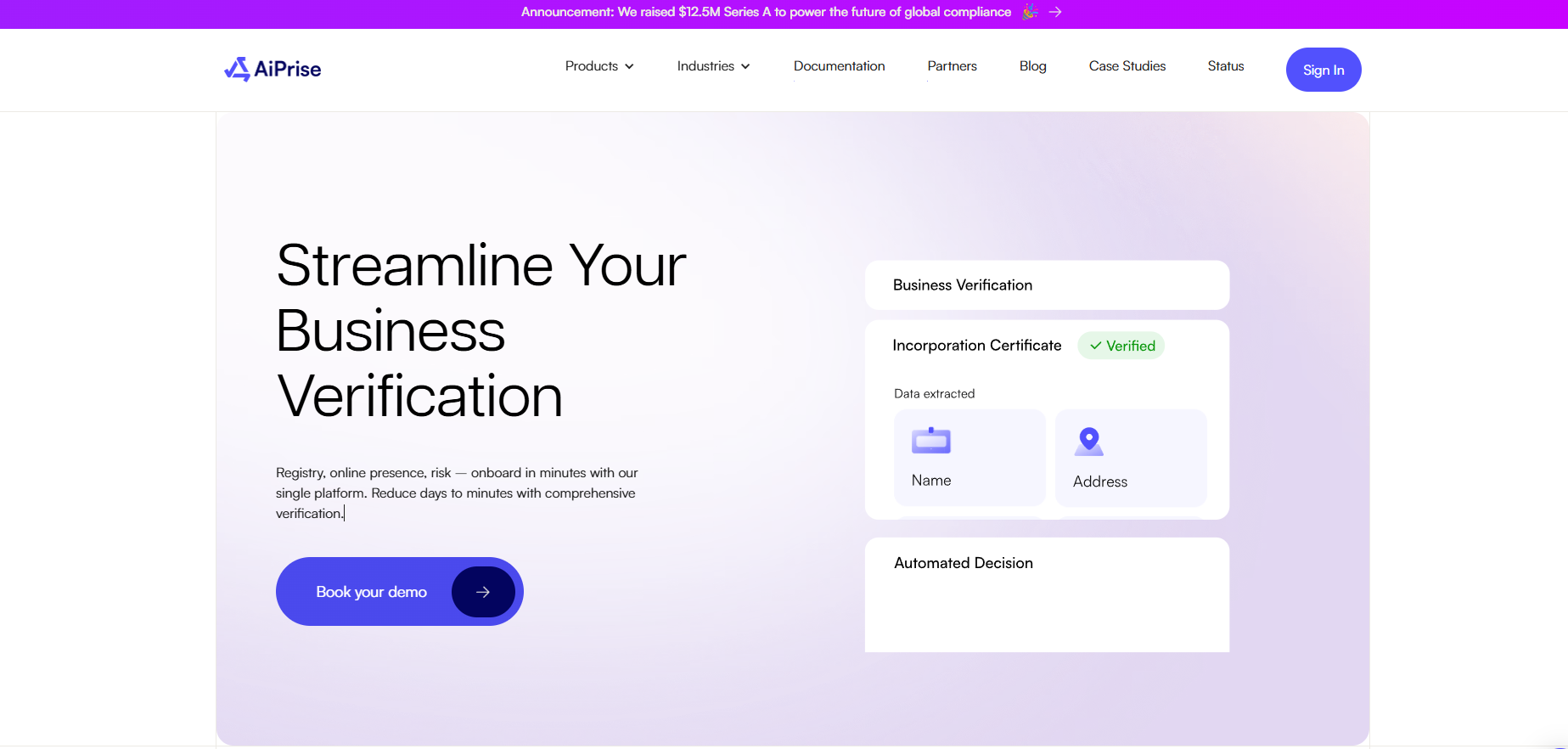
Gong gives AEs deep visibility into their buyer conversations. By analyzing call recordings and emails, it surfaces insights on sentiment, objections, and engagement trends, allowing reps to refine messaging and course-correct deals before they stall.
Gartner Rating: 4.7/5
Key features
- Automated call recording and transcription.
- Keyword and sentiment tracking for objections and engagement.
- Deal health indicators based on communication patterns.
- Coaching libraries and snippet sharing.
- Salesforce/HubSpot sync.
Pros
- Centralized visibility into conversations and follow-ups.
- Useful coaching artifacts for managers.
- Activity-based deal health signals.
Cons
- Transcription and sentiment can vary by call quality/accent.
- Analytics stop short of evaluator or proposal governance.
- A large volume of insights may require additional processing to operationalize.
Pricing: Subscription-based; Enterprise quotes are provided upon request.
Best for
Teams are standardizing call analysis and coaching across many reps.
3. Clari - Revenue Forecasting & Pipeline Intelligence
Clari acts as a real-time forecasting and pipeline intelligence engine for revenue teams. For Account Executives, it delivers instant visibility into deal health, risk signals, and conversion likelihood, supporting more predictable quarters and proactive pipeline management.

Gartner Rating: 4.7/5
Key features
- Predictive forecasting using CRM, email, and call signals.
- Revenue leak and “slipping deal” detection.
- Scenario planning and roll-up forecasts.
- Deal inspection dashboards.
- Integrations with Salesforce, HubSpot, and Google Workspace.
Pros
- Pipeline visibility for leaders and RevOps.
- Multi-level forecast roll-ups and trend analysis.
- Standardized deal inspection across teams.
Cons
- Output quality depends on CRM hygiene.
- Limited utility for evaluator-scored proposal work.
- Oriented toward leadership and RevOps over frontline proposal creation.
Pricing: Custom enterprise pricing by module and team size.
Best for
Organizations prioritize forecast accuracy and pipeline risk controls over proposal execution.
4) Humantic AI - Buyer Intelligence & Personality Profiling
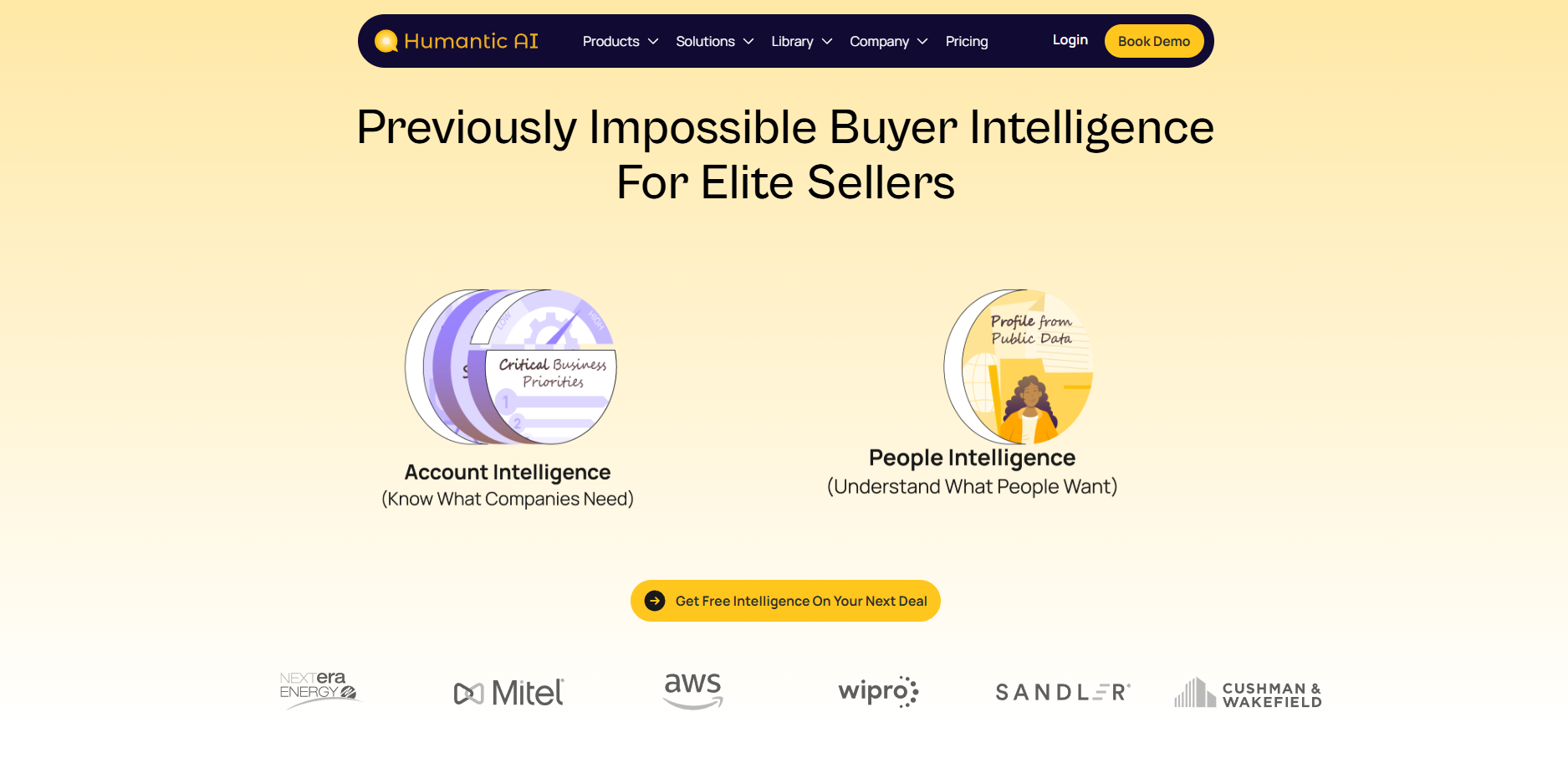
Humantic AI focuses on the human side of selling. It helps AEs understand each buyer’s communication style and personality type, making outreach more empathetic, personalized, and likely to connect from the first touchpoint.
Gartner Rating: N/A
Key features
- Personality and communication-style insights from public/CRM signals.
- CRM plug-ins for Salesforce and HubSpot.
- Email tone suggestions based on behavioral models.
- Buyer summaries for meeting prep.
Pros
- Aids early-stage personalization of tone and approach.
- Inline guidance within CRM records.
Cons
- Predictive in nature; not a substitute for governed content.
- Limited impact on proposal accuracy or compliance.
- It may be unsuitable where standardized wording is required.
Pricing
- Tiered, annual contracts; enterprise quotes provided on request.
Best for
AEs emphasizing early-stage, relationship-led outreach before formal proposals.
5) Momentum - AE Productivity Automation & CRM Sync
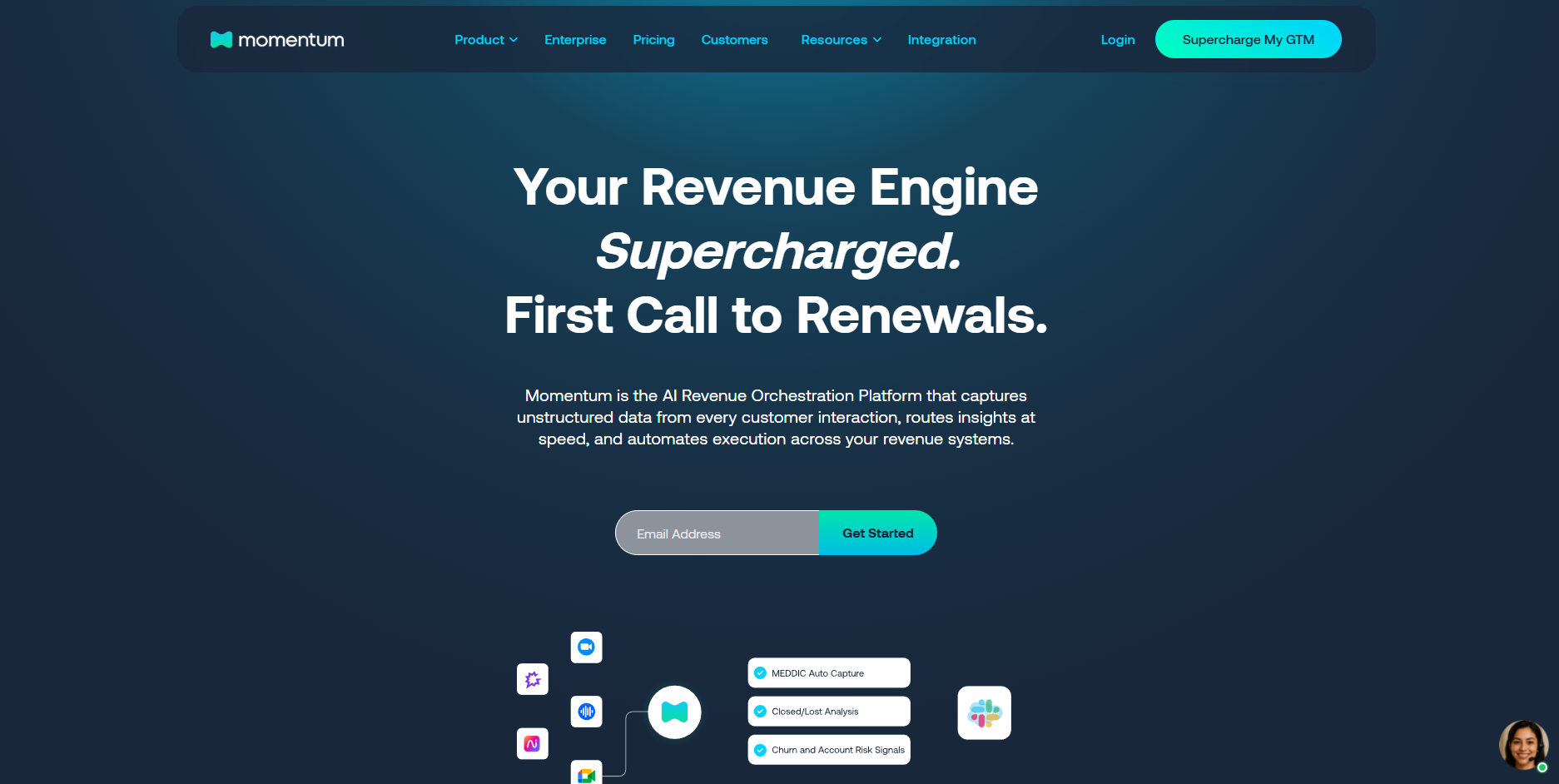
Momentum automates CRM data entry and meeting follow-ups so AEs spend less time updating systems and more time engaging prospects. It connects conversations, tasks, and deals in one unified view to maintain consistent pipeline hygiene.
Gartner Rating: N/A
Key features
- Auto-populate Salesforce fields after meetings.
- Workflow triggers to create follow-up tasks in Slack/Asana/Notion.
- Deal notes sync from AI transcriptions.
- Activity timelines for review.
Pros
- Reduces manual CRM updates.
- Connects notes, tasks, and pipeline views.
Cons
- Does not address evaluator scoring or proposal generation.
- Dependence on CRM data structure and process design.
Pricing
- Subscription; enterprise pricing on request.
Best for
AEs seeking lighter admin load and consistent CRM hygiene.
6) SalesHive - AI-Driven Sales Engagement Platform
.png)
SalesHive simplifies outbound campaign execution for AEs handling high-volume outreach. It uses AI-driven campaign creation, testing, and analytics to improve engagement rates without increasing manual effort.
Gartner Rating: N/A
Key features
- Campaign generation and multivariate testing.
- Engagement analytics on opens/clicks/replies.
- CRM sync via Zapier.
- Basic conversation summaries for follow-up tasks.
Pros
- Centralizes outbound campaign operations.
- Scales testing without manual lifts.
Cons
- Built for SDR outreach, not proposal workflows.
- Lacks evaluator-oriented content controls.
- Requires configuration and list governance.
Pricing
- Subscription; managed SDR programs billed separately.
Best for
Teams scaling outbound email programs and testing at volume.
7) ZoomInfo - Data Intelligence & Contact Enrichment

ZoomInfo equips AEs with verified company and contact data, plus intent signals that reveal which prospects are actively researching solutions. It helps build targeted lists and ensures outreach starts with accurate, compliant information.
Gartner Rating: 4.2/5
Key features
- Global B2B contact and firmographic database.
- Intent signals from the web and research activity.
- Automatic CRM enrichment for Salesforce/HubSpot/Dynamics.
- List building for sales engagement tools.
- GDPR/CCPA filters.
Pros
- Accelerates contact discovery and enrichment.
- Intent data to prioritize outreach.
- Broad CRM and engagement integrations.
Cons
- Data accuracy can vary by region and recency.
- Focused on top-of-funnel; no proposal creation or validation.
- Requires downstream tools to convert data into submissions.
Pricing
- Tiered subscriptions; enterprise quotes only.
Best for
Teams needing contact enrichment and intent targeting before proposal stages.
Suggestive Alternative
When outreach converts into formal RFPs or evaluator-led asks, use Inventive AI for governed, evaluator-aligned proposal automation.
8. 6sense - Predictive Account Intelligence
6sense helps Account Executives identify and prioritize in-market accounts earlier in the buying cycle. Its predictive intent data and buying-stage insights guide AEs toward deals most likely to convert.
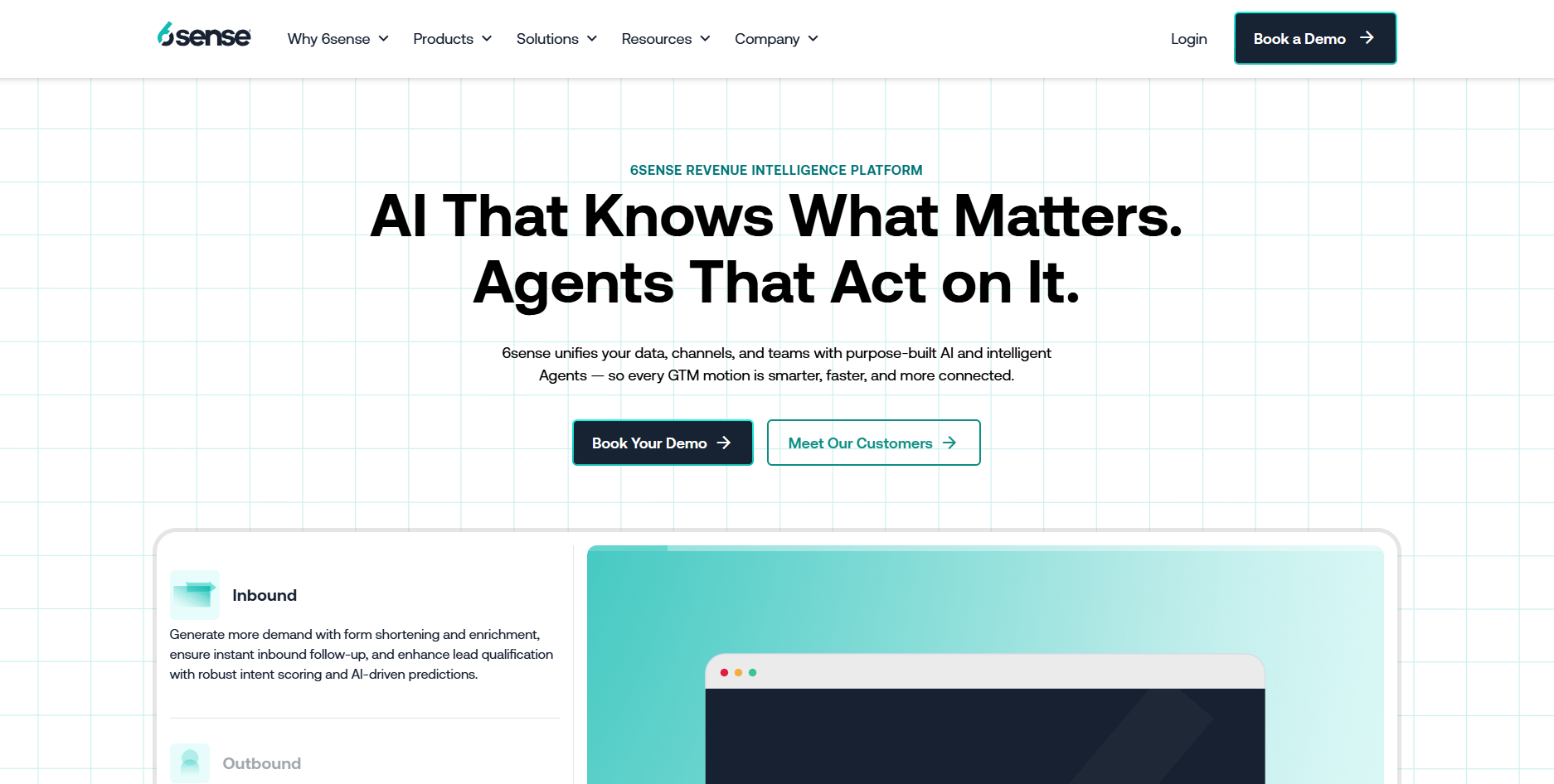
Gartner Rating: 4.4/5
Key features
- Predictive models for in-market account detection.
- Buying-stage and keyword-level intent insights.
- Pipeline prioritization dashboards.
- Integrations with Salesforce, Marketo, and Outreach.
- Campaign orchestration across sales and marketing.
Pros
- Helps focus on higher-intent accounts.
- Connects sales and marketing around shared signals.
Cons
- Digital intent may not reflect evaluator scoring factors.
- Requires cross-functional implementation.
- Not designed for proposal generation or governance.
Pricing
- Custom enterprise pricing; annual contracts.
Best for
Account-based programs that rely on intent signals to prioritize coverage.
Suggestive Alternative
For evaluator-scored submissions and document-level accuracy, route deals into Inventive AI to generate and govern the proposal content itself.
9) Highspot - Sales Enablement & Content Intelligence
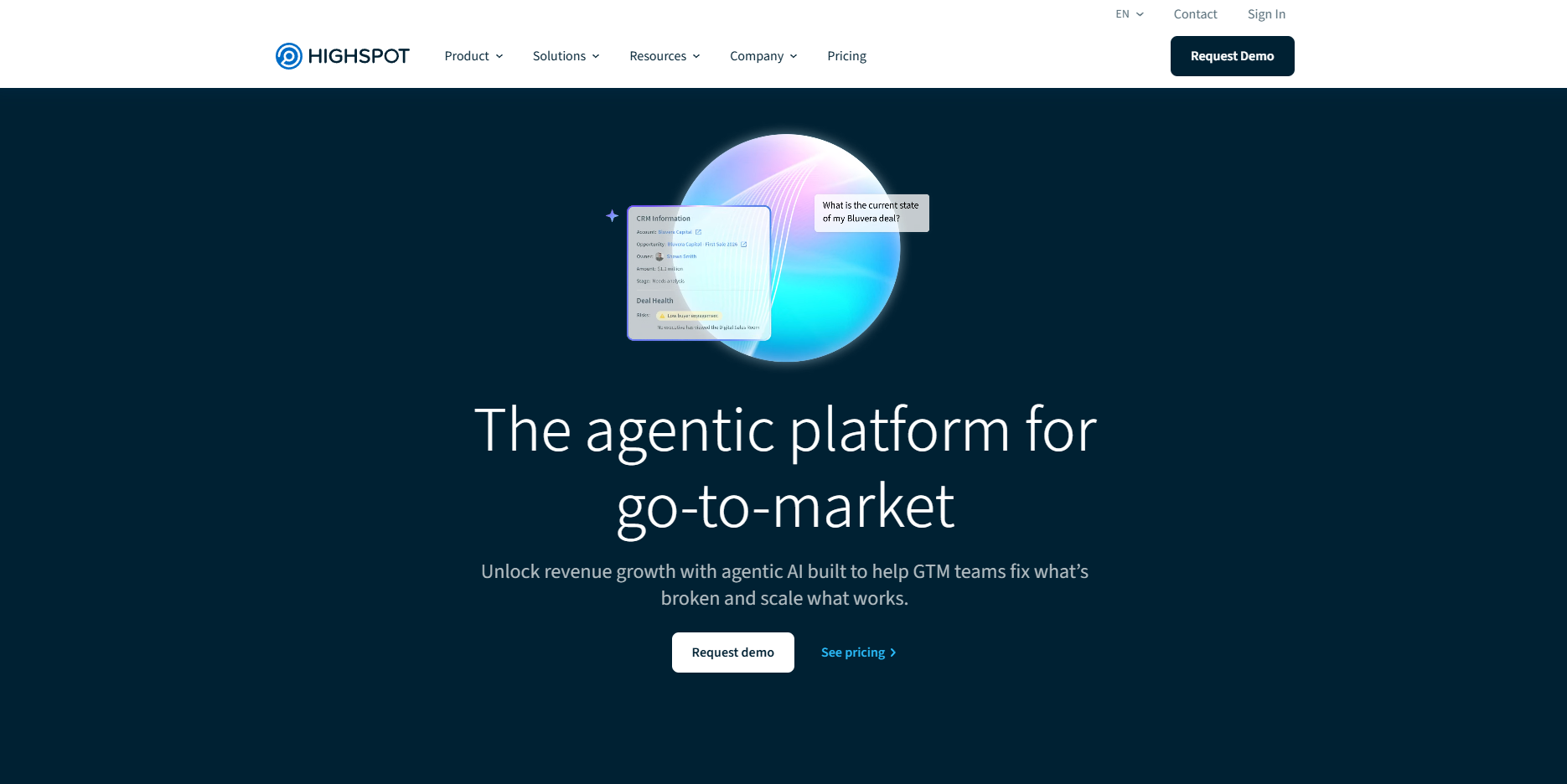
Highspot streamlines sales enablement by centralizing decks, playbooks, and collateral in one governed library. For AEs, it ensures they always use the most relevant, approved materials for proposals and presentations.
Gartner Rating: 4.7/5
Key features
- Central library for decks, case studies, and playbooks.
- Content performance analytics and guided selling.
- Salesforce integration to associate content with opportunities.
- Training and learning modules.
Pros
- Organizes collateral and tracks usage.
- Standardizes enablement materials at scale.
Cons
- Not built for customized, evaluator-driven proposal responses.
- Does not validate factual accuracy or compliance of submissions.
- Requires ongoing tagging and content maintenance.
Pricing
- Custom enterprise pricing; annual commitments.
Best for
Enablement teams managing marketing-approved content and training.
Suggestive Alternative
When deals require tailored, evaluator-aligned proposals rather than static collateral, use Inventive AI to draft and govern responses from verified sources.
Comparison of Top AI Tools for Account Executives in 2025
How to Choose the Right AI Tools for Account Executives
Not every AI tool is a fit for Account Executives. AEs work under pressure, balancing relationship building, pipeline management, and proposal accuracy, so the wrong platform can slow them down instead of helping. When evaluating AI tools, focus on these four non-negotiable factors:
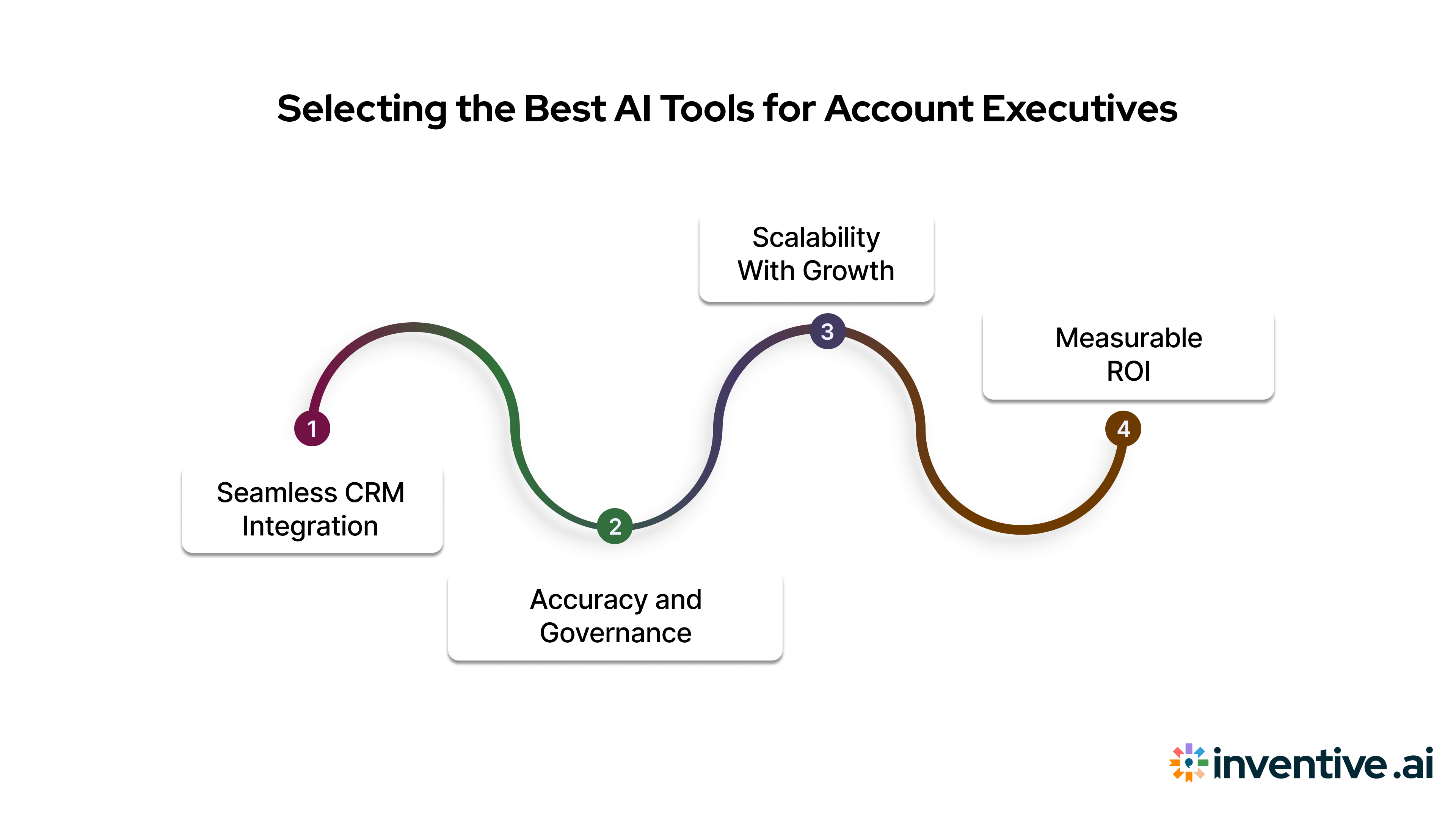
1. Seamless CRM Integration
Account Executives live inside Salesforce, HubSpot, or Dynamics. If an AI tool requires toggling between platforms, adoption will lag. The best solutions embed directly into CRM workflows, syncing contact data, pipeline health, and proposal content. For example, Inventive AI integrates with SharePoint, Slack, and CRMs to surface responses where AEs already work.
2. Accuracy and Governance
AI that generates content is only useful if it’s reliable. AEs can’t risk sending inaccurate proposals or emails to prospects. Look for platforms that ground responses in verified knowledge libraries, enforce version control, and provide audit trails. Inventive AI guarantees 95% accuracy and 0% hallucination, giving AEs confidence that every submission is compliant and consistent.
3. Scalability With Growth
As SaaS companies scale, AEs face more accounts, larger buying committees, and heavier proposal loads. AI tools must handle growing complexity without adding headcount. Prioritize solutions that support multi-region teams, role-based access, and collaborative workflows so AEs can manage more opportunities without sacrificing quality.
4. Measurable ROI
Executives will only back AI investments if there’s proof of impact. Tools should deliver quantifiable gains, such as:
- Faster proposal cycles (up to 90% faster first drafts)
- Improved accuracy (95%+ precision, 0% hallucination)
- Higher win rates (up to 50% lift by aligning with evaluator scoring)
- Time savings for AEs (less manual drafting, more time with customers)
Request vendor case studies or customer success data before committing and prioritize platforms that can demonstrate real-world ROI in your sales cycle.
Why Inventive AI is the Best Choice for Account Executives
Generic AI sales tools may help with prospecting or task automation, but they rarely solve the toughest challenges Account Executives face: proposal accuracy, evaluator alignment, and RFP deadlines. This is where Inventive AI delivers unique advantages.
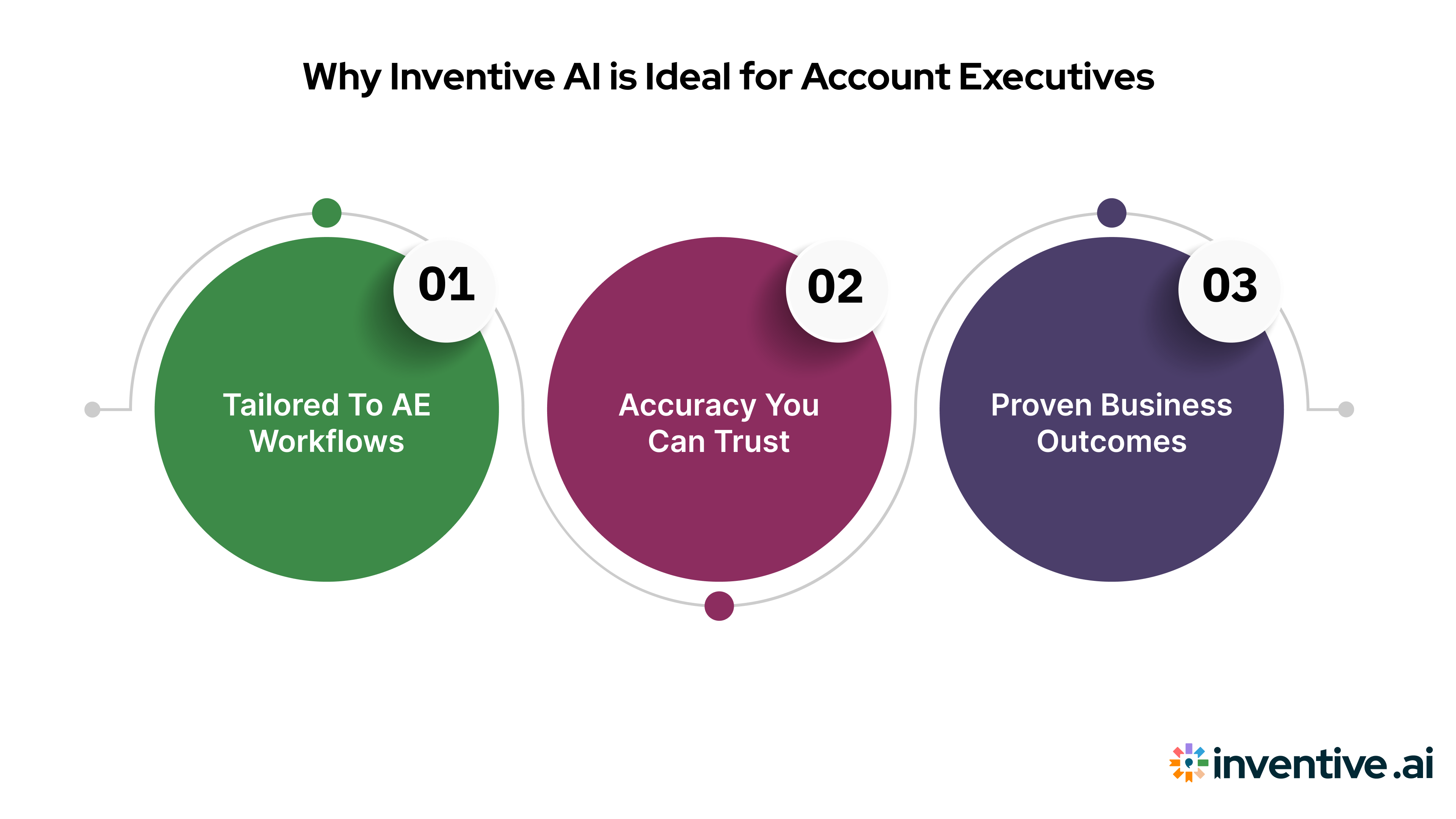
Tailored to AE Workflows
- High-volume proposals: Inventive AI auto-generates first drafts 10× faster, so AEs can respond to more opportunities without losing days to manual drafting.
- Evaluator-driven scoring: The proprietary Win Themes engine aligns every response to buyer criteria, ensuring proposals aren’t just accurate, but competitive.
- End-to-end integration: From Slack notifications to CRM syncs, Inventive AI fits into the systems AEs already use daily.
Accuracy You Can Trust
Unlike generic AI writing assistants that risk hallucinations or errors, Inventive AI guarantees:
- 95% accuracy grounded in verified company libraries
- 0% hallucination (flagging missing info instead of fabricating)
- Automated content governance that prevents outdated or conflicting answers
Proven Business Outcomes
Account Executives using Inventive AI report measurable results:
- 10× faster proposal drafts → reclaiming hours per deal cycle
- 50% higher win rates → by aligning proposals with evaluator scoring rubrics
- Stronger collaboration → real-time editing and audit trails across sales, presales, and compliance teams
With Inventive AI, Account Executives don’t just draft faster; they close smarter, with proposals that win.
Also read: RFP Content Management Best Practices and Tips
Conclusion
For Account Executives, AI has moved past the hype. It’s now a practical advantage in the field, helping AEs focus on what matters most: engaging buyers, managing complex deals, and delivering accurate proposals under pressure.
The wrong tools add noise; the right ones add leverage. By choosing AI platforms that embed into CRM workflows, ensure proposal accuracy, and align directly with buyer evaluation criteria, AEs can accelerate deal cycles and win more often.
That’s why Inventive AI stands out. With 10× faster first drafts, 95% accuracy, and zero hallucination, it gives Account Executives the confidence to handle more proposals, close larger opportunities, and consistently outperform competitors.
“Inventive AI produced the best-quality answers of every tool we tested — accurate, sales-ready, and fast.”
— Jason Campbell, Senior Sales Engineer, RAD AI
Frequently Asked Questions (FAQs)
1. How does AI help Account Executives in day-to-day work?
AI automates repetitive tasks like drafting proposals, logging CRM data, and retrieving technical content. This allows AEs to focus on higher-value activities such as building relationships, managing complex accounts, and strategizing win themes for proposals.
2. What’s the difference between generic AI tools and AI built for Account Executives?
Generic AI assistants can speed up drafting or email generation, but they often lack governance and accuracy. AE-focused platforms, like Inventive AI, are designed for compliance-heavy workflows, grounding responses in verified company data, ensuring 95% accuracy, and aligning proposals with buyer evaluation criteria.
3. Which AI tools are most useful for Account Executives?
The most impactful AI tools for AEs fall into three categories:
- Proposal automation (Inventive AI)
- Conversation intelligence (Gong)
- Pipeline forecasting & engagement (Clari, Outreach, 6sense, Demandbase)
Together, they cover the full AE workflow from prospecting to proposal delivery.
4. Is it safe to use AI tools for sensitive proposal and deal data?
Yes, as long as the platform is enterprise-grade. Tools like Inventive AI use role-based access, audit trails, and private data storage, ensuring sensitive deal information never leaves secure systems. Unlike generic AI, it never pulls from the open web, eliminating hallucination risks.
5. How quickly can AEs see ROI from AI adoption?
Most sales teams report ROI within 3–6 months. For AEs with high proposal volume, the impact is often immediate: faster responses, higher win rates, and more bandwidth to manage additional accounts without adding headcount.
6. Can AI replace Account Executives?
No, AI complements rather than replaces AEs. It handles drafting, data entry, and proposal governance, while AEs focus on strategy, buyer alignment, and relationship management. The best results come from AI and AEs working together.


